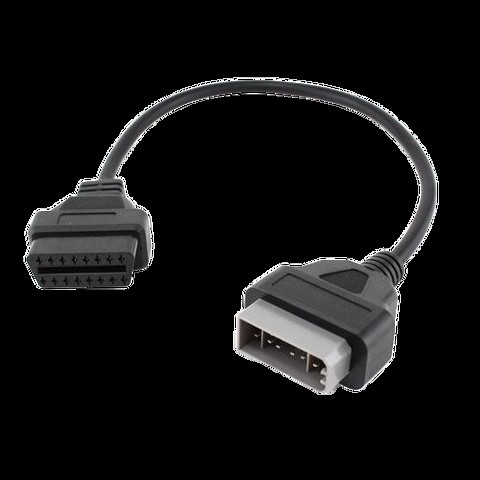Understanding your car’s diagnostic system is crucial for effective maintenance and repair. Many car owners often wonder about the compatibility between different On-Board Diagnostics (OBD) systems, specifically whether an OBD2 scanner can be used on an OBD1 vehicle. This article will clarify the differences between OBD1 and OBD2, and address the key question of scanner compatibility.
Understanding OBD1 and OBD2 Systems
OBD stands for On-Board Diagnostics, and it refers to the computer-based systems in vehicles that monitor and report on various vehicle functions. Over the years, automotive diagnostic technology has evolved, leading to two primary types: OBD1 and OBD2.
OBD1 was the earlier system, utilized in vehicles manufactured up to the mid-1990s, and in some cases, even later depending on the manufacturer and model. OBD2 is the more standardized and advanced system, becoming mandatory in the USA for all cars manufactured from 1996 onwards. While the transition to OBD2 was largely complete by the late 1990s and early 2000s, some vehicles were still produced with OBD1 systems even into the early 2000s.
For example, while a 2003 Toyota Corolla would typically be OBD1, a 2004 model of the same car is likely to be OBD2. This highlights that the changeover wasn’t always strictly year-based and could vary by model.
OBD2 offers significant improvements over OBD1. Notably, OBD2 provides standardized diagnostic trouble codes (DTCs) and a greater wealth of data from the vehicle’s onboard computer. This standardization simplifies diagnostics and ensures better compatibility across different scan tools and vehicles.
The Key Question: Will an OBD2 Scanner Work on an OBD1 Car?
The straightforward answer is no, an OBD2 scanner will not work on an OBD1 car. Despite the physical appearance of some connectors or the availability of adapters, OBD1 and OBD2 systems are fundamentally different in their communication protocols and the data they transmit.
OBD2 scanners are designed to communicate with vehicles using OBD2 protocols. OBD1 systems, on the other hand, use a variety of manufacturer-specific protocols that predate the standardization of OBD2. Therefore, a scan tool built to read OBD2 signals will not be able to understand or interpret the signals from an OBD1 system.
Adapters: Do They Bridge the Compatibility Gap?
It’s common to find adapters that convert the physical connector from an OBD1 port to an OBD2-style connector. However, it’s crucial to understand that these adapters only change the shape of the connector; they do not change the underlying communication protocol.
Nissan 14-pin OBD1 adapter for older Nissan vehicles.
Simply plugging an OBD2 scanner into an OBD1 car using an adapter will not enable communication. The OBD2 scanner still expects to communicate using OBD2 protocols, which the OBD1 system does not support.
OBD2 Port, OBD1 Protocol: Beware of Misleading Appearances
Adding to the confusion, some older vehicles may even feature a 16-pin connector that physically resembles the standard OBD2 port. However, this does not automatically mean the vehicle is OBD2 compliant. These vehicles might still operate on an OBD1 protocol, despite having an OBD2-style connector. In such cases, an OBD2 scanner will still not be compatible.
Diagram illustrating the standard OBD2 port, commonly found in modern vehicles.
It’s essential to verify your vehicle’s OBD protocol, especially if it’s manufactured around the OBD transition period, regardless of the port type.
Identifying Your Car’s OBD System
Determining whether your vehicle is OBD1 or OBD2 is crucial for choosing the correct diagnostic tools. Here are a few ways to identify your system:
- Manufacturing Year: As a general guideline, vehicles manufactured in 1996 and later are typically OBD2 compliant in the US. However, check your vehicle’s specifications, especially for models produced in the mid-1990s or early 2000s.
- Vehicle Manual: Your car’s owner’s manual should specify the OBD standard it uses.
- OBD Port Location and Type: OBD1 ports are often found in various locations, sometimes under the dashboard on the driver’s side, or even in the engine bay. They come in various shapes and pin configurations, often not the standardized 16-pin OBD2 shape.
Example of a Toyota 22-pin OBD1 port, commonly located in the engine bay of older Toyota models.
- Check Vehicle Emission Sticker: Some vehicles have a sticker under the hood or on the driver’s side doorjamb that indicates OBD compliance.
Choosing the Right Scan Tool
For OBD1 vehicles, you will need a scan tool specifically designed to read OBD1 protocols. These tools are often more comprehensive and capable of handling the diverse protocols used in OBD1 systems.
Toyota 22-pin OBD1 adapter, necessary for connecting OBD1 scan tools to Toyota vehicles with this port type.
If a scan tool is compatible with OBD1 protocols, it will almost always be capable of reading OBD2 as well. However, a scan tool designed solely for OBD2 will not work with OBD1, even with the use of an adapter.
Conclusion
In summary, an OBD2 scanner is not compatible with OBD1 vehicles. Adapters can physically connect the devices, but they do not bridge the communication gap between the different diagnostic protocols. To diagnose an OBD1 car, you need a scan tool that is specifically designed to support OBD1 protocols. Always verify your vehicle’s OBD system type before purchasing or using any diagnostic tools to ensure compatibility and avoid frustration. Understanding these distinctions will help you choose the correct equipment and effectively diagnose your vehicle.

